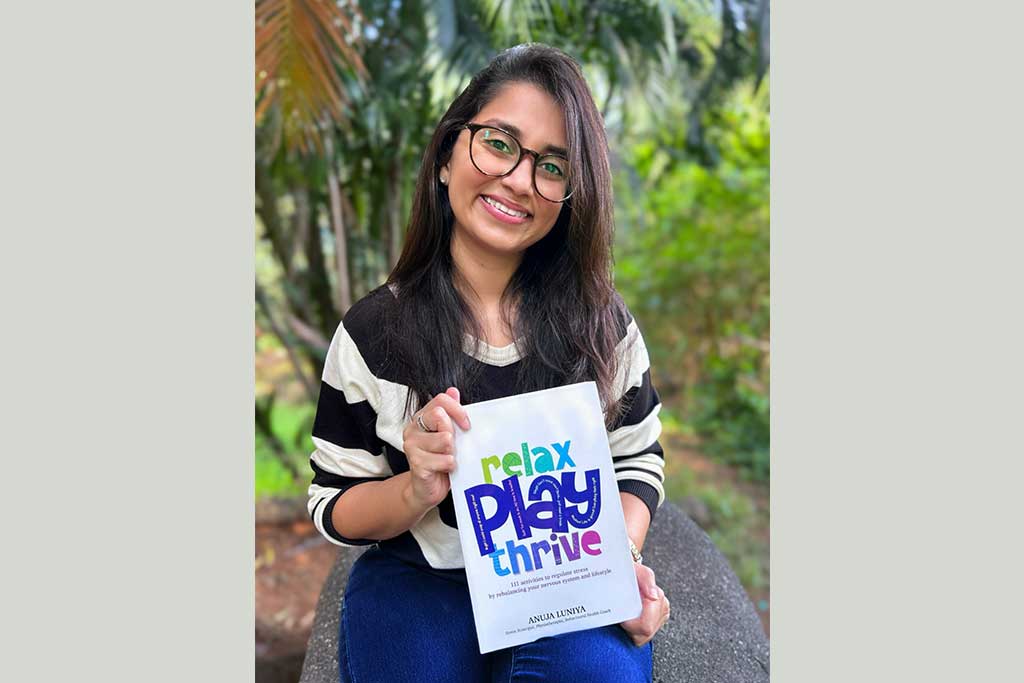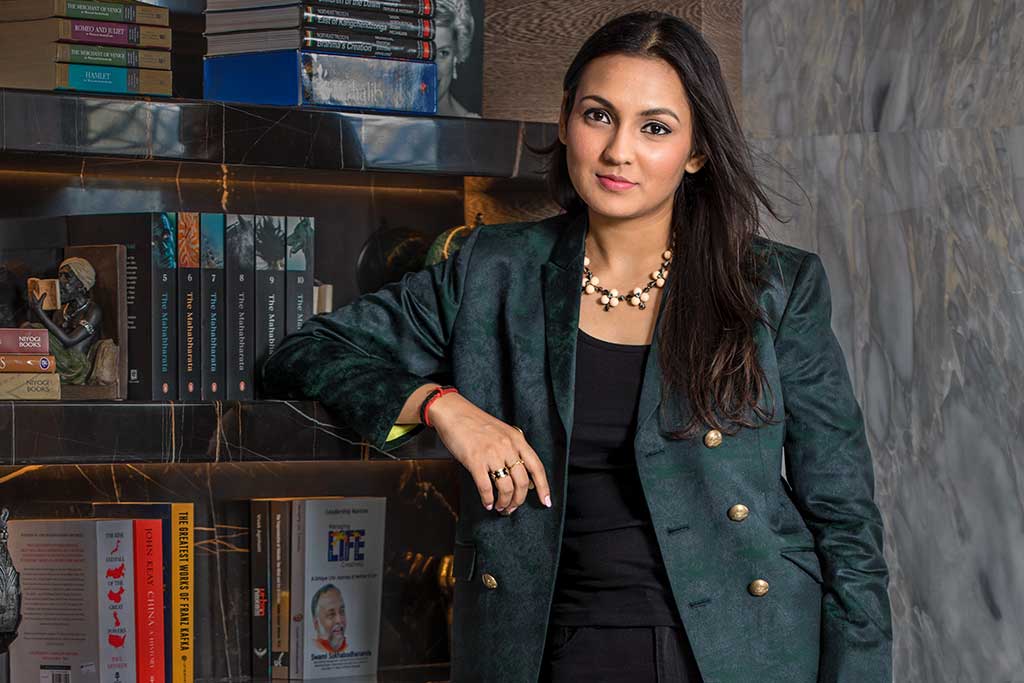Jaipur-based jewellery designer Sunita Shekhawat is preserving the art of meenakari and reinventing it to suit modern sensibilities. In an interaction with MARWAR, she discusses her love for colour and craft, her Rajasthani roots and her soon-to-be launched meenakari museum.
From starting as a first-generation jeweller three decades back to owning a signature jewellery label today, Sunita Shekhawat has come a long way. Her jewellery atelier on Narayan Circle in Jaipur—inaugurated by Maharani Gayatri Devi—is layered with vintage treasures and statement pieces based on the old-world charm of meenakari and heirloom jewellery. Her intricately crafted jewellery comprising necklaces, pendants, earrings, rings and bangles, can be worn for generations to come. Called as the modern meenakar of India, her prized possessions are adorned by royalty, industrialists, political and celebrities with pride.
Shekhawat’s design language speaks of architectural influences and elements of Rajput heritage and culture. “The architectural elements like jharokha, chhatris and jaalis that can be found from Jaipur’s palaces to the forts of Mewar and Marwar loom large in my designs. I love to combine floral motifs with geometric patterns derived from these buildings,” explains the designer who sets herself apart from conventional jewellery makers with these hallmarks and defining moments in her journey.
Passion for jewellery
Born into a Rajput family in Osian Thikana, a small village near Jodhpur in Rajasthan, Shekhawat’s initiation into the jewellery industry had a lot to do with her childhood and upbringing. Owing to her forefathers’ links with the raj gharanas of Jodhpur, she had access to the magnificent handcrafted jewellery that inspired her to create designer jewellery herself. She gives special credit to schools, particularly those emphasising CCA that lay emphasis on craft training in a holistic way. She undertook formal training in jewellery designing and gemmology to learn the basics of colour clarity of stones, and branding and marketing skills which eventually helped her launch her own brand ‘Sunita Shekhawat Jewellery’.
Twenty-five years later, Shekhawat looks at her journey as a jewellery designer with love and pride. “As a first-generation boutique owner, I had to start from scratch as I forayed into a path where many others had not.


Naturally, this was not an easy journey. Being a male-dominated business, everyone from the dealers to artisans—was skeptical of my foray into meenakari. I continued to persevere and maintain consistency, always open to learning from the people around me, including the craftsmen (karigars) who were initially hesitant to work with a woman! Slowly, I was able to break the bubbles and build a warm symbiotic relationship with these men, and had a beautiful mechanism of working together,” elaborates the designer who, believes that womanhood is about striking a fine balance.
She, however, won’t deny the rebellion streak she possesses since childhood. Inspired by the strength, composure and perseverance of the women of her community and family that have come before her, she resisted the tag of not being able to do something and set her against fresh challenges and adventures. On account of her father’s Indian Air Force profession, she had the opportunity to travel across India that also shaped her cosmopolitan outlook.
Inspired by colour and craft
For inspiration, Shekhawat returns to her childhood days. Her design template is deeply guided by the sights, colours and sounds of native Marwar (and the rest of Rajasthan). Scenes of local markets where crafts ranging from block printing to carpet making are practised, hyperlocal festivals are celebrated, and the palaces, deeply influenced her. “Colour came naturally to me,” says the jeweller whose love for Shekhawati jewellery (traditional jewellery made by families catering to royalty) and meenakari is well known.
It was her colourful childhood that created a natural attraction to the enamel meenakari. “This was also a time when many businesses were using fake coloured gems. I substituted this with meenakars, provided them with training and reoriented them to the vision of the brand. Some of my most prized possessions in jewellery are my traditional aad and my Golconda diamond ring.”

Shekhawat’s love for meenakari also inspired her to undertake her labour of love, the Sunita Shekhawat Meenakari Museum, that will soon be launched in Jaipur. “The museum is a tribute to the city and the craft and envisioned as a natural part of our journey. It emphasises on the skill and vision of the craftsmen and celebrates the historic journey of meenakari that goes beyond Jaipur to the Mughals and Persia,” she adds. The museum will function as a unique cultural space where people will be educated about meenakari craft and its significance to Indian jewellery.
Delivering beyond expectation
Shekhawat brings transparency to the table and provides a holistic experience to her customers. With personalised attention, she ensures her jewels are an object of adoration. Every piece of her jewellery is passed through the hands of skilled craftsmen and goes through the processes of sculpting, painting and engraving to meet her clients’ expectations. “It is always easy to promise but difficult to deliver. I guide my interactions with my clientele with this axiom. The strategy is to never make high-flung promises but to try and deliver more than the expectation.” She believes that jewellery design that comes straight from the heart has an intangible communicative value that crosses boundaries to reach the hearts of the customers. She moulds her jewellery according to the needs of her client to bring out that relatability factor. “For me, the greatest compliment is when people come from all walks of life and say that my pieces are one of a kind!” she smiles.
Another challenge for a designer is to temper one’s creative instinct with the logistical and technical requirements to keep the business running smoothly. “It is a classic case of conflict between the mind and the heart,” says Shekhawat who seamlessly balances the creative and design aspects with the manufacturing and marketing processes with the support of her husband Dileep Singh and her children Digvijay and Niharika. “The banking and finance-related matters were easily handled by my husband right from the start, giving me time to focus on the creative aspects of the brand. Over the years, as our operations expanded, my children joined in to help in running the business smoothly. Digvijiay manages the creative aspects of jewellery making and Niharika deftly handles the communications, branding and outreach of the brand. With niche strengths, they add value to the brand in their own way and have helped to expand our presence even further.”


The family bonding
While having her family on board has turned into a blessing, it is in between the bustle of business that they also share the most intimate family moments. The business has brought the family closer together and fostered interaction in ways that would not have been possible if the brand did not exist. Another example of their bonding as a family unit comes through the fact that the family had adorned traditional Sunita Shekhawat jewellery at Digvijay’s wedding held recently. “The matha-patti, nath and rakhri are some specific elements of the Marwari wedding that we had adorned. We made it a point to stick to traditional attire and ornaments that have been our family heirlooms for generations. In clothes, a palette of yellows, orange, reds, and such bright colours are my choice and both my daughter and daughter-in-law were dressed in red for their weddings to honour the special meaning that the colour carries for a bride. I dressed up in the same poshak that I wore for my daughter Niharika’s wedding. These timeless pieces passed down from one generation to another hold great emotional and auspicious power,” she emphasises.
Shekhawat likes to start her day at a relaxed pace. “My mornings begin slowly, as I try to ground myself with some activities before beginning the day. I spend time with my mother, tend to my garden, sit with my dogs and take updates from the household help on things I need to do before leaving for work.” At work, her schedule is dictated by the needs of the brand and she also tries to catch up with her employees by personally interacting with them. Her work cabin is open to all—an attempt to foster a culture of accessibility and creative collaboration. She unwinds by listening to podcasts, bhajans, and doing yoga and meditation. Abida Parveen’s rendition of Kabir’s dohas is her personal favourite. She is passionate about travelling and returning to old school habits like shopping for saris in bazaars and frequenting vintage shops selling furniture, crockery, books and furniture.
Every designer looks up to an industry expert and Shekhawat is no different. “I resonate with Bvlgari due to their love for colour and the choices they make therein.” A celebrity she would like to deck up? “I find muse in any woman who understands jewellery beyond a statement or commodity, someone who can appreciate the craftsmanship and story behind the piece,” she concludes.
Recent Posts
Discover Your Perfect Honeymoon in the Maldives
For Indian couples embarking on their journey of togetherness, the Maldives has long held an almost mythical allure - a tapestry of turquoise
Jewels Fit For Generations : The Nemichand Bamalwa Story
Since 1987, Nemichand Bamalwa Jewellers has been more than just a name; it is a legacy of trust, craftsmanship, and innovation.
Welcome to "What's Your Plan?"
This vibrant social hub by DJRS Hospitality blends chic vibes with gourmet bites,
Rajasthan’s Crafty Fashion Takeover
Rajasthan, India’s desert jewel, is a repository of exquisite and time-honoured crafts.
‘Mercii’ Beaucoup, Mumbai!
Stepping into Mercii at 81 Crest, Khar, feels like entering a world where gratitude is plated with every exquisite bite.
Game. Set. Watch: Omega Celebrates Smriti Mehra
Luxury Watch Boutique Time Avenue, Mumbai, in collaboration with Omega, hosted a special event to honour none other than Smriti “Simi” Mehra,
Sand, Sea & Sky - High Thrills
Whether you’re soaking in serene natural beauty or diving into extravagant fun, the UAE offers the perfect setting for an unforgettable family getaway.
Dr. Anuja Luniya Shows You How to Stress Less, Live More
Meet Dr. Anuja Luniya, physiotherapist by degree, stress strategist by passion, and your go-to guru for turning everyday chaos into calm.
Breitling's 140th-Anniversary Vintage Watch Exhibition: An Unmissable Showcase
The Breitling Heritage Exhibition, a remarkable showcase of the brand’s most iconic timepieces from its 140-year history, has been on an extensive global tour with 55 stops across four continents.
Dawn to Dusk with Sidhart Pansari: Steering Primarc's Legacy into the Future
We follow the dynamic director of the fastascendant Primarc Group
4 Perfect Getaway Resorts Near Mumbai
For those looking to break away from the urban bustle, India's hidden nature
48 Hours In Canberra
Canberra is a vibrant city with a rich culture, awe-inspiring natural landscapes, adventure-filed activities, and hospitable locals.
Understated Power
In the charming town of Shillong, Meghalaya, golf is more than just a game—it's a family affair for Gaurav and Lakshya Bajaj.
Understated Power
The Lexus LX500d is a rare sight on the roads, and this exclusivity is where its distinctive charms resides.
The Money Manager
Engaging young, ambitious, tech-savvy successors to manage family wealth is a rising global need among the super-rich.



















